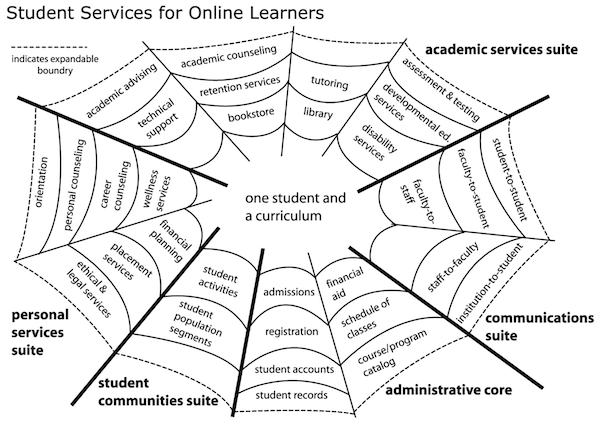Published on
Striving For Student Services Nirvana: Will We Ever Arrive?

The traditional institutional ecosystem that was in place when I arrived was profoundly challenged when we obtained permission to offer degree plans online, since learners could then be anywhere and engage in learning at anytime. Navigating a new model meant the institution needed to completely rethink how it would offer support services online. Since all the research relating to online education was far in the future, we were navigating in uncharted waters, searching for the best ways to meet learner needs in an online environment.
One of the early writings relating to online learning that still resonates today was the Five Pillars of Quality Online Education published by Sloan-C (now the Online Learning Consortium). In this framework, Frank Mayadas, then-president of Sloan-C, affirmed that “any learner who engages in online education should have, at a minimum, an education that represents the quality of the provider’s overall institutional quality.” The inter-related quality pillars included learning effectiveness, access, scale, faculty satisfaction and student satisfaction. The student satisfaction pillar’s goal focused on the idea that “all students who complete a course express satisfaction with course rigor and fairness, with professor and peer interaction, and with support services.” The highlights from the pillar go on to say, “As consumers, students are satisfied when provider services—learning resources, academic and administrative services, technology and infrastructure support—are responsive, timely and personalized.”[1]
Another early publication that sought to provide an actionable blueprint for early online administrators was Quality on the Line: Benchmarks for Success in Internet-Based Distance Education authored by Jamie Merisotis and Ronald Phipps in 2000. The study, commissioned by the National Education Association and Blackboard and conducted by the Institute for Higher Education Policy, identified 24 benchmarks in seven categories that became a roadmap for many in the field. At the time, the four Student Support Benchmarks were a starting place to think about the role of student services.[2]
Two years later, the Western Interstate Commission for Higher Education (WICHE) produced the Guidelines for Creating Student Services Online. My current institution, Kansas State University, joined with Kapi’olani Community College (HI) and Regis University (CO) to develop this student services framework.[3] Below is a visual of their “web” of student services for online learners that represented the structure of student services at the time, and still has relevance:

Yet as we consider this illustration, I wonder what aspects might be revised to address the changing higher education landscape we find ourselves in today. For example, how might we modify this graphic to help address these questions: In what ways are the services we provide supporting persistence and student success? Have the expectations of learners changed our thinking about services over the years? In an era of tightening higher education budgets, what learner support services are considered essential and non-negotiable?
While it would be great to say that every institution has achieved student services nirvana, I imagine that if we were to ask 20 leaders in the field about their institutions, most would feel that they still have lots of work to do. From my perspective, student services is an area where most of us will forever continue in a never-ending quest to adapt to new challenges. This is exemplified by the multitude of directions institutions are taking to support their learners.
Today, many have embraced success coaching models to assist learners in navigating the institution, their academic program, institutional and community resources and life’s curves. Others are tapping into more personalized approaches to learning through the implementation of adaptive courseware solutions and just-in-time learner support networks to enhance engagement and achievement, while still others are focused on the use of open educational resources to support student success, flexibility and quality. In addition, other institutions have focused on onboarding and 2+2 or 3+1 pathway tools and initiatives, group coaching and mentoring models, mobile solutions. The list could go on and on.
Your students’ needs and expectations, as well as your institutional context and vision, will in many ways shape your entire institution’s future, putting you on a quest for a path to student services nirvana. I encourage you to engage with others at conferences and workshops as well as keep an eye on the best practice award programs that are part of many professional organizations. Others might join me in taking up the challenge of re-envisioning WICHE ‘s student services web graphic.
What is apparent to me today is that there isn’t a single right or wrong path to student services nirvana. That is why today’s sharing community is so critical!
Author Perspective: Administrator



